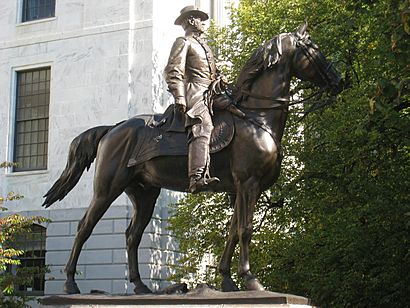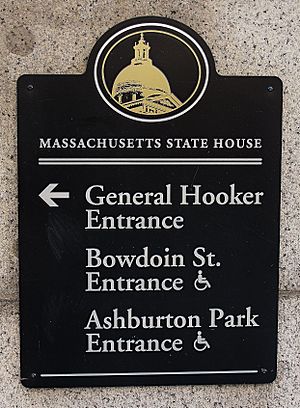Equestrian statue of Joseph Hooker facts for kids
Quick facts for kids Equestrian statue of Joseph Hooker |
|
|---|---|

The statue in 2008
|
|
| Year | 1903 |
| Medium | Bronze sculpture |
| Subject | Joseph Hooker |
| Location | Boston, Massachusetts, U.S. |
An equestrian statue is a statue of a person riding a horse. This statue shows Joseph Hooker on a horse. It's sometimes called General Joseph Hooker. You can find it outside the Massachusetts State House in Boston, facing Beacon Street.
Joseph Hooker was born in Hadley, Massachusetts. He was an officer in the United States Army. He fought in the Mexican–American War and became a major general in the American Civil War. His statue stands about 15 feet (4.6 meters) tall. It was first shown to the public in June 1903. There was a special ceremony with an artillery salute. Many military and government leaders attended.
History of the Statue
This bronze statue was made in 1903. It was designed by Daniel Chester French and Edward Clark Potter. The statue stands on a base made of granite. In 1997, it was checked by the "Save Outdoor Sculpture!" program. This program helps protect outdoor art.
Lawmakers approved US$55,000 in public money to create the statue. At first, the statue had a bronze sign. It said, "A Soldier in the Army that Kept the Nation Whole." But groups of veterans asked for this sign to be removed. They felt it made Hooker's leadership role seem less important.
Even though his soldiers liked him, honoring Hooker in such an important place has been debated. A historian named Charles Francis Adams Jr. served in the Civil War. He said he would not walk on the same side of the street as the statue. He felt the statue was an insult to other Massachusetts soldiers. He believed Hooker did not represent the typical soldier from Massachusetts.
In 2017, many Confederate statues were being removed in the Southern United States. At that time, The Boston Globe newspaper said the Joseph Hooker statue was one of those that made people wonder, "Why Are These Statues Even Here At All?" The newspaper quoted Peter Drummey from the Massachusetts Historical Society. He said that "Hooker didn't have a very good reputation as a soldier or as a person." Drummey thought the statue might be there to show the political power of veterans' groups. It might not be just to honor Hooker himself.
The Hooker statue is still open for people to see. This is true even after the September 11 attacks in 2001. After those attacks, the gates to the State House lawn were closed. This limited access to other statues like those of Anne Hutchinson, John F. Kennedy, Henry Cabot Lodge, Horace Mann, and Daniel Webster.
General Hooker Entrance
The statue is in front of the main public entrance to the State House. This entrance is named after General Hooker. There is a large sign that says "General Hooker Entrance."
In 2018, State Representative Michelle DuBois asked for the name of the entrance to be changed. She said the name was "tone deaf." She felt it showed "disregard for the majority of women's feelings." She explained that women who work in the State House hear uncomfortable jokes because of the name. However, Governor Charlie Baker and other state officials decided not to change the sign.
See also
 In Spanish: Estatua ecuestre de Joseph Hooker para niños
In Spanish: Estatua ecuestre de Joseph Hooker para niños



